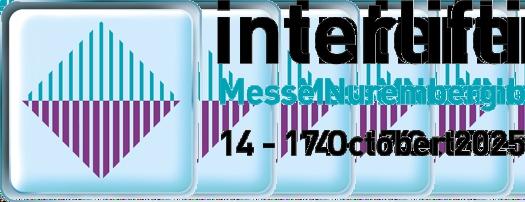








































































The global street lighting market size was valued at USD 9.10 billion in 2023 and is expected to grow at a CAGR of 3.6% from 2024 to 2030. The growing urbanization and infrastructure development projects drive the market's growth. As the global population increasingly moves toward urban areas, cities are expanding, and new urban zones are being developed. This rapid urbanization creates a heightened demand for infrastructure that supports safe and functional public spaces, with street lighting playing a vital role in this process.
Street Lighting Market size is projected to witness lucrative gains from 2024-2032 impelled by the growing initiatives for providing safety and visibility on roads in dark conditions across the globe. Street lighting devices deliver improved visibility to motorists and pedestrians for aiding in significant road safety. The increasing government and private investments are driving the ongoing measures to develop public infrastructure facilities. To cite an instance, in March 2023, MIGA offered guarantees to KLED Capital and CIFI LATAM to assist in the installation, operation, and maintenance of an upgraded streetlight network in Saint Lucia. The project aims to replace 22,000 sodium streetlights on the island with LEDs and install 2,460 new LED streetlights, resulting in a GHG emission reduction of 5,000 tons of CO2e annually while boosting the level of lighting by more than 30% throughout the road network.
By fostering innovations and synergies, companies are partnering to expand their reach, accelerate product development, and address the evolving customer needs. For instance, in January 2024, Fluvius announced plans to upgrade over 1 million streetlamps in Belgium to LED technology by 2028. In addition, the rapid urbanization and developments in various urban areas are generating a high demand for streetlights in line with the surging emphasis on smart city projects and zero-carbon emissions programs. However, budget limitations, regulatory challenges surrounding energy efficiency standards, and the initial high costs of modernization may slow down the market expansion to some degree.LEDs are set to gain high popularity in the street lighting industry through 2032, due to their beneficial properties, such as energy efficiency, longer life expectancy, low carbon emissions, and accurate color rendering. The soaring demand for energy-efficient lights in streetlights to reduce energy consumption is supporting the higher implementation of LEDs. The decreasing price and the rise in government subsidies for supporting implementation will also fuel the product demand.
Street lighting industry size from the controller segment is set to depict exponential growth from 2024 to 2032 due to its easy maintenance and increased energy-saving features. These control systems are utilized for monitoring and controlling the lighting devices. Integration with several sensors, dimmers, and timers into the control system allows greater energy management, further providing energy efficiency. With the increasing adoption of smart lights and LEDs, controllers have become essential for the efficient working of devices.
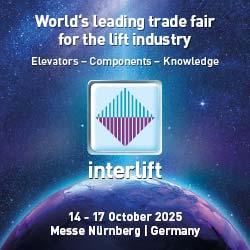
Since its beginning in 1991, interlift has grown continu ously and, with almost 19,000 visitors from over 110 countries, has cemented its status as the world's leading trade show for the lift industry. 500 exhibitors helped to shape the final edition in Augsburg and are waiting in the wings for the Nuremberg premiere from 14 to 17 October 2025. But numbers alone are not enough to describe the most important platform for the global lift community.
Nuremberg – interlift enables close encounters and in-depth insights –Massimiliano Petrolli, responsible for marketing at the Munich-based lift door specialist Meiller, describes the added value as follows: “In an increasingly digital world, direct dialogue at trade fairs like interlift remains irreplaceable.” No other event or communication platform enables such close encounters and in-depth insights, Petrolli continues. “At the same time, the trade fair offers the opportunity to present products that require explanation in detail in direct dialogue,” he adds, emphasising the important function for industry newcomers to make valuable contacts.
encounters are what make interlift so appealing
Federica Codalli, Marketing Manager at the Wittur Group, with lift component factories all over the
world, describes the magic of interlift as follows: “It's the informal encounters with industry players that make the real magic of the show. A chance encounter, an open and face-to-face conversation, and suddenly the seeds of a groundbreaking connection are planted. Business collaborations that have influenced the market often didn't start in the boardroom, but between the glasses raised to toast at interlift.”
Important driver for construction industry and smart infrastructures
The professional sponsor of interlift is the Association for Lift Technology VFA Interlift e.V. It brings together the interests of small and medium-sized lift and component manufacturers. Achim Hütter, Chairman of the Association, comments on the situation in the industry:
“Our industry is robust overall. Topics such as urbanisation, accessibility and energy efficiency continue to drive strong demand. Despite geopolitical tensions and volatile supply chains, the industry remains an important driver for the construction industry and the development of smart infrastructures.”
Michael Gubisch, Deputy Chairman of the association, describes the function of interlift as follows: “Due to its size and internationality, interlift can be described as the leading global trade show for the lift industry.” He expects more than just a more modern infrastructure and a more relaxed hotel situation from the move to Nuremberg.
“The excellent international connections will noticeably improve accessibility,” says Gubisch. And the larger space will create added value
for everyone involved with more spaciousness and new services. The change of location was discussed in advance with all important partners.
The exhibitors also have high hopes for Nuremberg. Federica Codalli from Wittur, for example, believes that the overall experience for exhibitors and visitors will be improved. “We also believe that the new location will contribute to an even more international flavour of interlift,” says Codalli. Massimiliano Petrolli from Meiller expects optimal conditions thanks to more and more functional space. “The Nuremberg exhibition centre presents itself as an ultra-modern venue with well thought-out logistics and optimal connections,” Petrolli continues.
Michael Löffler, Project Manager of interlift, confirms the great interest in the new location: “More than 50 companies have travelled to Nuremberg specifically to get an impression of the new home of the leading trade show for the lift industry.”
Naturally, the opportunity was also taken to familiarise interested parties with other advantages of the location by taking short tours through the picturesque old town, says Löffler. At the exhibition centre, interlift is a perfect circuit of Halls 1, 3, 3A, 3C, 4 and 4A. It is accessed via the Eingang Mitte (Central Entrance – for public transport travellers) and the Eingang Ost (East Entrance – for individual travellers).
Broad spectrum of trade visitors
The results of the last visitor survey paint an impressive picture of interlift: 84% of visitors have
procurement expertise. 9% of visitors come from North and South America, 71% from Europe, 3% from Africa and 16% from Asia/ Australia. The top 3 areas of interest are lift components, doors and lift systems. Controls/regulators, cabins and safety technology are also very popular. The top 3 industries among visitors were lift construction, maintenance/repair and installation. However, lift technology, mechanical engineering and trade were also widely represented.
92% rated the programme as very good to satisfactory - an increase of 9 points on the previous event. A total of 93% confirmed a positive overall impression. At 92%, the recommendation rate and the intention to return are only slightly lower.
Key dates and visitor services
The next interlift will take place from Tuesday, 14 to Friday, 17 October 2025 at Messe Nürnberg.
Nuremberg is easily accessible from alldirections.Travellingbytrainis particularlyenvironmentallyfriendly, with the underground taking travellers from the main station to the exhibition centre in just eight minutes. Nuremberg Airport offers numerous direct flight connections fromalloverEuropeorworldwide via the daily hubs in Amsterdam and Istanbul. For hotel bookings, there are booking portals of the Nuremberg Congress and Tourism Centre and the Nuremberg region.
For detailed information on travelling and accommodation: https:// www.interlift.de/en/travelaccomodation/
https://www.interlift.de/en/

The push-button interfaces from JUNG offer an optimum solution for the integration of sensors and switches in the KNX system. Building owners benefit from more security and energy efficiency. Thanks to the compatibility with KNX Data Secure, the pushbutton interfaces are tamper-proof. They can also be updated with the JUNG KNX Service App.
Push-buttons, door or window sensors, hotel card or key switches can be easily integrated into the KNX system via the floating contacts. This enables intelligent control of lighting, heating, air conditioning and other electrical devices. Another major advantage of the push-button interface is its versatility. It supports leakage and condensation sensors as well as temperature sensors and
door and window contacts. This allows building owners to increase the security and energy efficiency of their building.
With two, four or eight independent channels, the installer can parameterise each channel as an input or output. The push-button interface can also send telegrams to the bus based on read-in pushbutton/switch statuses.
This enables precise and reliable control of the connected devices. Neighbouring input channels can be combined when push-buttons, door or window contacts are connected. This allows complex logic functions to be realised. It is also possible to block individual channels of the push-button interface. This enables targeted
control and management of the connected devices. Another advantage of the new push-button interface is its compatibility with KNX Data Secure. This offers a high level of tamper protection in building automation and can be easily configured via the project design in the ETS. The devices can be updated and can be conveniently supplied with firmware updates via the Jung ETS Service app.
With the KNX push-button interface,
various switch types such as installation switches, push-buttons, reed contacts (door/window contacts), leakage/condensation sensors, temperature sensors, Mini Basic motion detectors, pulse counters and outputs can be integrated into the KNX system. In a hotel, the KNX push-button interface with the FFNTC temperature sensor can be used in a variety of ways. For example, it automatically adjusts the room temperature in hotel rooms and thus offers guests optimum comfort.
By integrating leakage and condensation sensors into the KNX system, the push-button interface enables reliable monitoring and early warning of moisture and water damage. This allows measures to be taken to minimise damage and warranty the safety of the building.
By connecting reed contacts to the push-button interface, users can monitor the status of doors and windows.
The push-button interface has a pulse counter with main and intermediate counters. This enables the accurate recording and monitoring of pulses, for example for measuring energy consumption or recording meter readings. www.jung-group.com/en-DE/ Products/Systems/KNX-buildingtechnology

As LED tape is now ubiqui tous in new lighting schemes, Simon Buddle explains how combining it with the flexibility of KNX can lead to stunning effects that are more costeffective than other solutions.
The slow transition to LED, I would say, is pretty much complete. I haven’t seen an incandescent lamp installed in a new home for a very long time now. We’ve been through those initially painful years where the various new technologies were trying to catch up with each other. First, we saw the advent of the LED for home lighting, then lighting control manufacturers had to design and build new dimming actuators for the market.
Then we realised that not all LEDs dimmed well, or even at all in some cases. We’ve had years of lamps that flicker, and dimming that is not smooth but steps down, stage by stage, in what can only be described as dimming by staircase steps. And then those pesky lookalike filament LEDs came to town. Many with a minimum load so low, that even when the dimmers were off there was the faintest of glow from them.
Certainly, one of the biggest changes I’ve witnessed over the last five years is the proliferation of LED tape in the home. Previously, the only way to light a large, coffered ceiling was to use neon or fluorescent tubes, neither of which gave off a particularly pleasing light when compared with the consistent warm yellow glow of the 12V halogen. And many times, we’d see colour discrepancies over time as the tubes slowly decayed.
LED tape, however, brings its own
set of challenges which we talked about last year in my article ‘Residential Lighting: the advantage of using KNX drivers for LEDs‘. Drivers and power supplies have to be in the space, cable runs for 12V and 24V must be considered for voltage drop and with that comes the need to ensure the colour and luminosity.
There are three areas where colour changing may be used in the home. Let’s look at them:
This works by having yellow LEDs and blue/white LEDs next to each other. So, by using two sets of LEDs along the length of a single tape, it is possible to mix the two colours. The principle of tuneable white is very straightforward. It does require a DT8 compatible KNX DALI actuator. These are known as DALI2.
On a recent installation we completed, all of the LED tape was controlled from a single slider on the KNX user interface so that all of the tape in the house exactly matched in colour. The colour temperature of the tape can be changed from 2700K to 6500K very easily by the homeowner. One thing to look out for is the density of LEDs on the tape. The higher the density the less likely you are to see spotting on the tape.
Colour changing is so easy now in the KNX world, with products such as the Zennio Lumento that enables you to connect all four colours to a single driver. Oh, and they also do versions that can be configured for tuneable white or just four independent LED tapes. That is a great
option when you’ll need drivers anyway, so why not bring them straight into KNX and save that additional driver cost? Colour changing is one thing, but how about setting it to music?
The Zennio Lumento supports the connection of all four colours to a single driver. DMX DMX512, as it is officially known, can do exactly that. What’s the
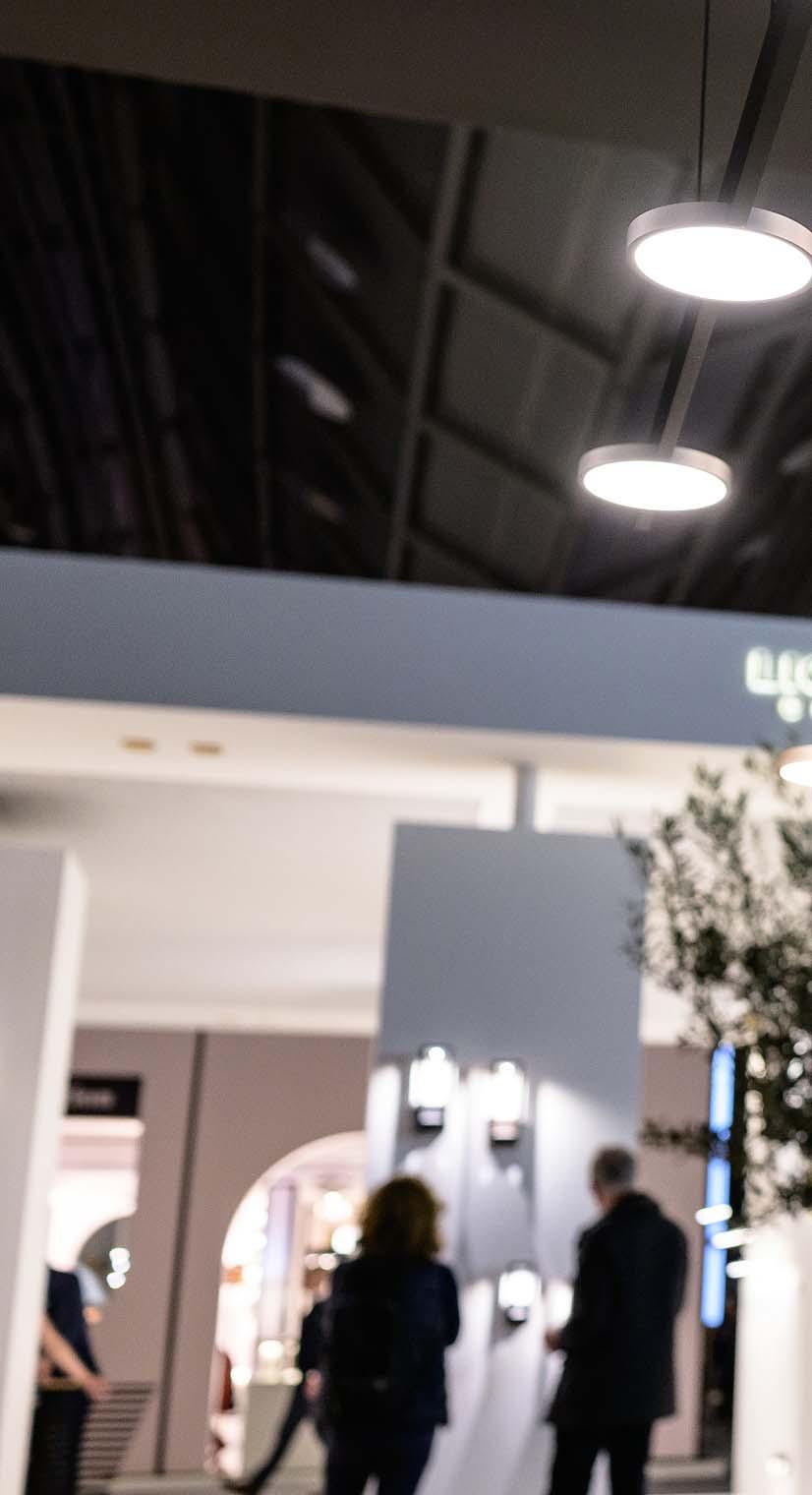
difference between RGBW and DMX? Well, fundamentally, nothing in terms of the LEDs, although there are some spectacular LED arrays for stage performance. DMX is really designed for the stage and theatre. The difference is in the speed of communications. A DMX controller can react at super-fast speed which means that it can change in time to the music being played. If you couple DMX with MIDI (Musical Instrument Digital Interface) you have the basics of instruments controlling lights. Hit a certain key on a synth and on comes a particular light. KNX can absolutely control a DMX setup, but if you want the LEDs to ‘dance’ in time to the music you’ll need some sort of microphone or audio line input into the DMX to make that function work. That is worth a discussion with the client.
LEDs can ‘dance’ in time to music.
Conclusion
LED is pretty much a done deal for most homeowners, and colour changing
can add something special to the home. One of the great joys of KNX is that it can interface with all types of worlds or technologies; we are not stuck with one manufacturer or communications protocol. We can talk to DMX, replace LED drivers with our own KNX versions which are far more intelligent and dim considerably better than most off-the-shelf drivers. And if that weren’t enough, we can also easily integrate DT8 colour changing into the mix as well.
I don’t know of any other system that can bring together all those diverse lighting technologies at anything close to the price of a KNX system.
All it needs is a little bit of design time up front to discuss and agree the client’s needs and we can create amazing lighting aesthetics for our customers. Simon Buddle CEng MIET, is a consultant for Future Ready Homes, a specialist in BMS and ELV services system design.

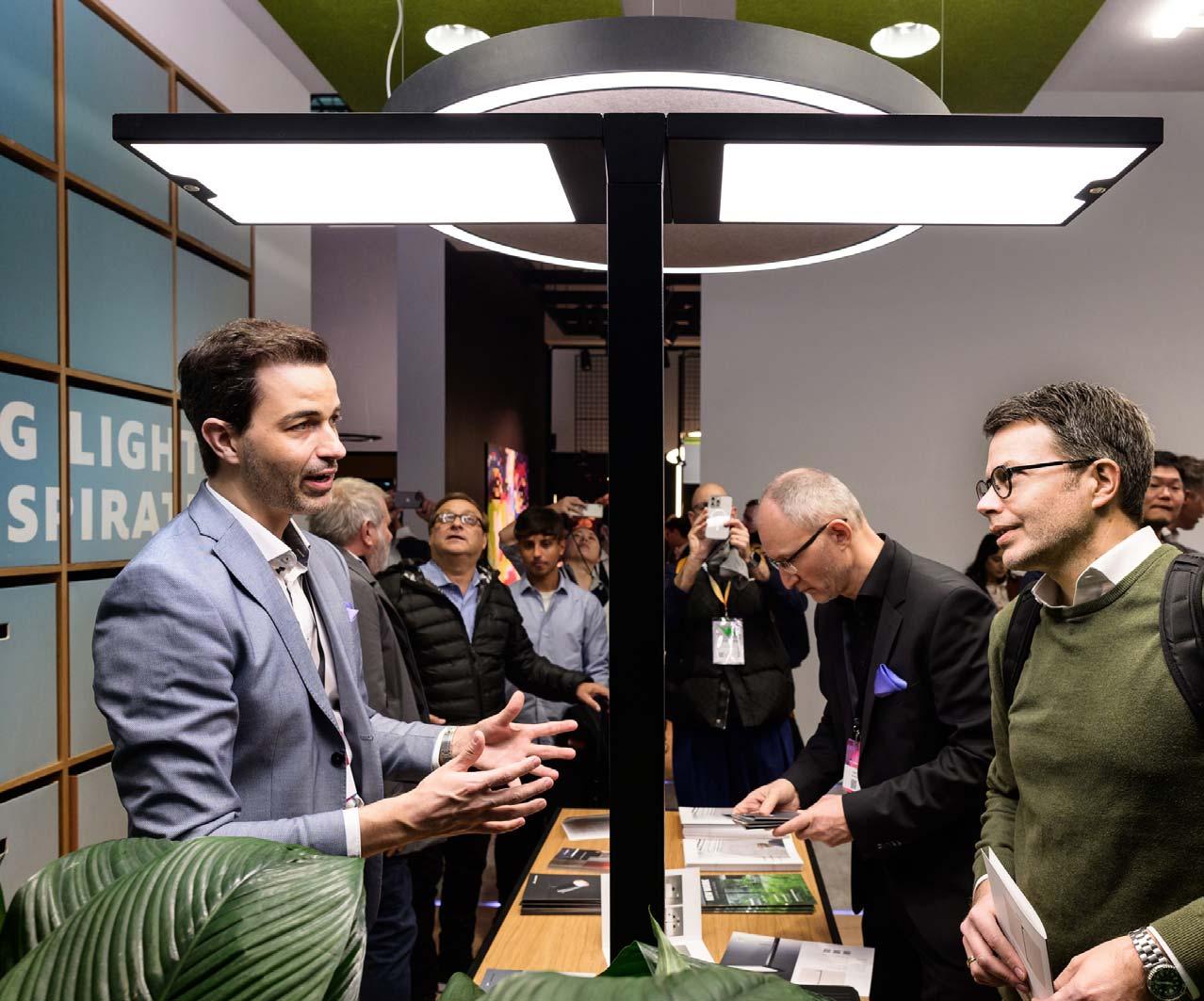
energy-efficient environments for living and working, and outlines why KNX technology offers the ideal choice in terms of space flexibility, adaptability and maintainability.
Paul Foulkes looks at the way we must adapt buildings to provide safe, healthy and
Covid has affected almost every aspect of our lives, and how we work has been a key area that has changed. Initially, we worked from home, and a lot of us struggled with this new dynamic, but as we slowly return to our offices, we find that the
workplace has changed. Even with the most recent relaxation of Covid measures in the UK, the office is very much different to how it was in early 2020. All of these changes have led us to be much more aware of our working environment – for ‘work space’ read ‘social distancing’, for ‘room temperature’ we now also think of ‘ventilation’ and ‘air quality’. Even at home, these are things we now consider.
In the commercial environment, we
have learned that flexibility isn’t just about linking a sensor with the HVAC or some lights – it’s about being able to tailor the building for new layouts and ever-changing levels of occupancy. With continuing rises in energy costs, maintaining optimum energy efficiency is another factor that we all must consider.
These new issues will be of concern to us at all levels of interaction,

whether we be end-users, managers, or facilities management (FM) teams. This means as constructors and integrators, we must consider these elements in our new building designs, as well as see if we can deal with them in our existing buildings.
The office space is changing – we were used to hot-desking, but Covid has forced us to re-assess shared space. It has to be flexible but also easily cleaned to keep it healthy. Social distancing means space is at a premium so businesses are exploring the possibilities of contactless work environments. At the same time, working from home, for many of us, will remain in some form, and mixing this work environment with our home life will require new approaches to residential buildings.
A lot of offices will have some form
of BMS, so changes may be possible. We know that KNX has the full capabilities, across multiple commercial and residential building topologies to effect the changes required. Ensuring that new buildings include this flexibility, adaptability and maintainability will come from design collaboration that can be driven by the KNX integrator. Existing buildings can adapt if KNX is already at the core of the BMS installation.
Space management linking to real occupancy usage and ventilation adaptation is essential. The control solutions must factor in energy management, with lighting control and efficient, comfortable heating. Thanks to a choice of sophisticated presence detectors, KNX offers a perfect solution to this by integrating intelligent lighting control with multiple types of HVAC. There are pixel-based sensors that go a step
further by keeping count of how many people are in a space in real time. This can be used to provide feedback to restrict access when an area is full, or to increase the ventilation to ensure fresh, clean air is provided in more confined spaces when more people arrive. This is pre-emptive control rather than reacting to already high levels of CO2. Using KNX to integrate motorised doors, it would be simple to create a completely contactless environment as people move through a building and use different spaces. A scenario could be as follows: in a high-rotation office space, a group of people have booked a meeting room. This booking was carried out remotely and logged on the building system. When they enter the room, it has been brought up to temperature for them ten minutes before the meeting was due to start. The lights turn on as they enter, dependent on ambient light levels. They log in so their presence is recorded, and the
system adjusts based on the number of people actually using the room. The system monitors CO2, temperature, light and shading, and adjusts heating, lighting and ventilation accordingly, in real time, exactly dependent of the prevailing conditions and use case. This is truly effective real time space management.
At home, things are slightly different. The same requirements exist, namely adequate ventilation, suitable lighting and the correct heating, all managed to the highest levels of energy efficiency. Modern housing should be able to fulfil this from outset, rather than by having to add Internetdependent gadgets. KNX can play the central role in residential development and, for instance, help to achieve the requirements set out in the recently-revised and updated UK building regulations.
Dark Sky: precise light beams without spill light
Easy programming: with 0-10V or Bluetooth

12 light distributions incl. zoom and framing optics

Adjust light color dynamically: with Tunable white and RGBW
www.erco.com/beamer-site

Outstanding lighting design combines aesthetics with technical precision, creates atmosphere, stages architecture –and provides inspiration for shaping the built environment. These are precisely the qualities represented by the IALD International Lighting Design Awards. In 2026, this prestigious accolade will be presented for the first time at Light + Building in Frankfurt am Main. This gives lighting design a new spotlight at the trade fair.
Light + Building, the world’s leading trade fair for lighting and buildingservices technology, is the international meeting place for lighting designers, architects, planners and decision-makers who are actively shaping the future of lighting. With the IALD Awards being presented for the first time in March 2026, the creative dimension of light moves even more into focus at this international industry event.
The IALD International Lighting Design Awards are among the world’s most prestigious accolades in the field of architectural lighting design.
Presented by the International Association of Lighting Designers (IALD), they honour projects that stand out for their design excellence, technical precision and atmospheric impact. As the international counterpart to the German Lighting Design Award, they set standards and showcase visionary lighting solutions. The 43rd edition will be held in March 2026 in cooperation with the IALD as part of Light + Building.
"Light + Building is the central platform for lighting design in a global context – an inspiring place where creative ideas, technical innovations and visionary concepts come together. With the IALD International Lighting Design Awards
being presented in Frankfurt for the first time, the trade fair gains a new dimension of visibility and becomes even more attractive for the international lighting design community," says Steffen Larbig, Director Brand Management Light + Building.
Light – a key focus of Light + Building
Light in all its facets is at the heart of Light + Building: manufacturers from around the world present pioneering lighting concepts for interior and exterior spaces – from smart, minimalist solutions to surprising lighting effects. The international platform for lighting and buildingservices technology makes modern lighting design tangible in all its diversity – visually, technically and atmospherically.
High-quality events complement the exhibitors’ offerings: lectures, presentations and talks at the Design Plaza provide in-depth insights into current trends, topics and projects. Guided tours offer orientation and fresh perspectives.
Already in 2024, the IALD was a guest at Light + Building – including as part of the Women in Lighting programme at the Design Plaza, moderated by Sharon Stammers, Light Collective. (Source: Messe Frankfurt Exhibition GmbH / Pietro Sutera)
Already in 2024, the IALD was a guest at Light + Building – including as part of the Women in Lighting programme at the Design Plaza, moderated by Sharon Stammers, Light Collective. (Source: Messe Frankfurt Exhibition GmbH / Pietro Sutera)
IALD – Partner for outstanding lighting design
The International Association of
Lighting Designers (IALD) is a globally leading organisation for professional lighting designers. For over 50 years, it has been committed to the promotion and recognition of outstanding lighting design. The IALD International Lighting Design Awards have been presented since 1983 and represent the highest quality in architectural lighting.
The 42nd IALD International Lighting Design Awards will be held on 7 May 2025 at Lightfair Las Vegas. Lightfair is part of the global Light + Building network, which encompasses a total of 14 trade fairs across five continents, providing companies with global access to the most important growth markets for lighting and building services technology.
Light + Building 2026 – The World’s Leading Trade Fair for Lighting and Building-Services Technology
The next edition of Light + Building will take place from 8 to 13 March 2026 in Frankfurt am Main. It brings together leading manufacturers with planners, architects, designers and investors, and offers a unique platform for exchanging ideas on the latest developments in lighting, electrical engineering, building automation and security technology.
Companies confirming their participation by 30 April 2025 will benefit from attractive early booking conditions and a non-binding stand space proposal. Regular stand rental rates apply from May onwards. Further information on participation is available at: www.light-building.com/participation
Light + Building - the world's leading trade fair for lighting and building services technology. The Light + Building event will take place from 8 to 13 March 2026. www.light-building.com
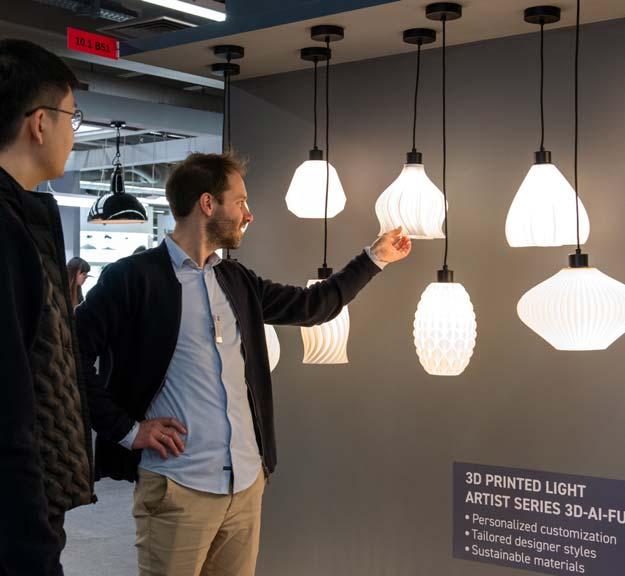










Over thirty years ago, Q-Tran was born with a vision: to manufacture superior power solutions. As we grew, we expanded our offering to include the highest quality LEDs and fixtures, positioning us as a leader in architectural lighting. Now it’s time that our brand reflects the dynamic, innovative company we’ve become.
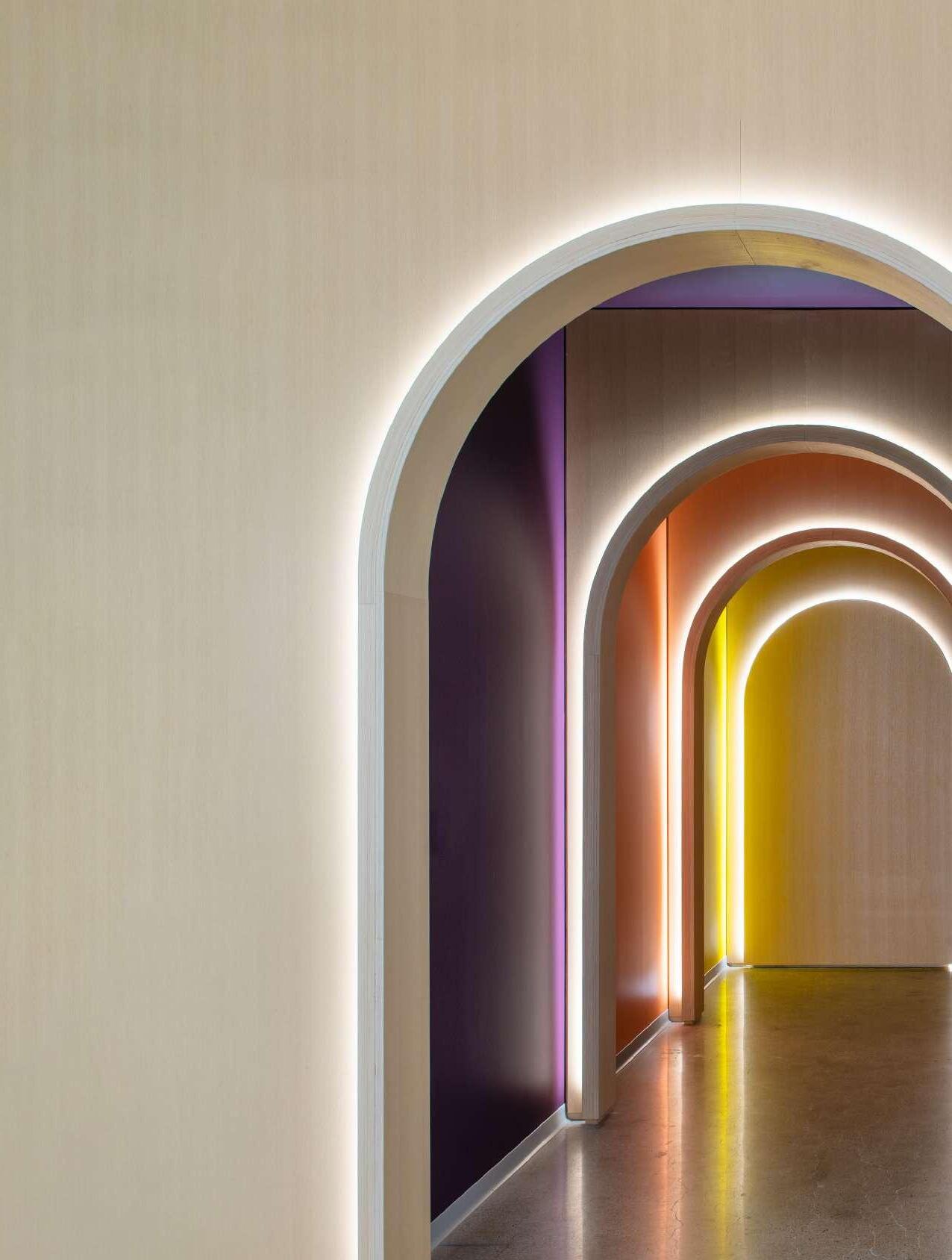
Autodesk | Boston, MA
Lighting Designer: Lam Partners Architect: Utile Photographer: Chuck Choi
EAE is established in 1973 and is a global company which has sister companies in Germany, Italy, Australia, USA, UAE and Russia. EAE exports its products to 112 countries, and has many regional offices all around the world.
EAE Technology is a member of EAE Group of companies and develops and produces intelligent building solutions with open protocols such as KNX and DALI. At the same time, EAE Technology is an R&D center and KNX training center. As of today, EAE Technology products are in use in 60 countries. The mission of the company is to develop smart automation systems and devices that improve and facilitate people’s environmental conditions, as well as saving energy.
EAE Technolgy gained trust and established long term relationships with all its customers due to its focus on customer satisfaction.
Providing long time warranty, fast response are very important strenghts of the company.
Also, giving short leadtime despite worldwide supply chain problems and microprocessor crises made EAE Technology’s brand value on a different positions on its customers mind.
Creating difference in the rapidly developing technology world depends to have a dynamic quality system and to make it sustainable. EAE Technology’s Quality Management System passed many international audits.
EAE Technology differantiates the products with testing each and every device for all functions. Despite the process is costly with the requirement of extra manpower, time and focus, EAE Technology is aware of the imposrtance of customer satisfaction.
EAE Technology, with its experienced R&D team, follows the innovations closely and develops products which is on the front line of global new trends and presents them to the market.
EAE Technology continues to develop patented products and features that bring a new perspective to different sectors.

EAE Technology took its place in the online market with the acceleration of the growing online shopping. EAE Technology established online stores in Germany, France, Italy, Spain and UK.
Five language options are added to EAE Technology’s website and products’s technical files and ETS databases.
We are looking for local Channel Partners for execution of online stores and to establish and govern the sales network in these countries.
In today’s world, the demand for seamless control solutions in both residential and commercial spaces is ever-growing. ABB Yurika, built on the open KNX protocol, stands out as a versatile solution designed for British Standard installations. It effectively manages a wide array of functions, including lighting, air conditioning, floor heating, blinds, and scenes. These innovative products not only enhance the user experience but also ensure that control is intuitive and accessible.
At the heart of the Yurika design is an intuitive LCD display that visualises text and icons digitally. This feature allows for easy updates and personalisation, catering to the specific needs of users. The combination of the digital interface with physical push-buttons ensures a user-friendly experience, making it easy for anyone to interact with the system. Whether in commercial settings or residential homes, ABB Yurika is tailored to fit any environment, providing a sophisticated control solution that meets diverse requirements.
One of the standout features of the Yurika portfolio is its special enhancements for hospitality applications. With an emphasis on guest experience, ABB Yurika is the ideal choice for modern hotels looking to elevate their service offerings. The system’s design and functionality are optimized to create a welcoming and efficient environment for guests, ensuring their comfort and satisfaction.

Style and technology go hand in hand with the latest updates to the ABB Yurika control elements. The expanded colour range now includes colours such as White, Silver, and Champagne Gold, alongside the all-new Matt Black, providing a contemporary aesthetic that fits seamlessly into luxury interiors.
Moreover, the introduction of metal rocker options, including Premium Stainless Steel, Mocha Brown, and Antique Gold, enhances the overall look and feel of Yurika control elements. These stylish additions not only elevate the design but also ensure that smart control has never looked this good.
In response to the specific needs of the hospitality industry, ABB Yurika has introduced several new features that enhance guest service and operational efficiency. The new Room Outside Panel is a key addition, allowing guests to easily control their environment with features such as Do Not Disturb, Make Up Room, and SOS icons. This level of customization ensures that guests have a personalized experience tailored to their preferences.
Additionally, the integration of an occupancy detection logic allows hotels to optimize energy use while
maintaining guest comfort by key cardless presence detection via door contacts and other sensors to automate scenes and to help housekeeping to verify guest presence.
With ABB Yurika, hotels can offer unparalleled comfort, efficiency, and smart integration, setting a new standard in hospitality. Elevate your property with intelligent control solutions that blend style and functionality, ensuring that both guests and staff enjoy a seamless experience.
In conclusion, ABB Yurika is more than just a control element; it is a comprehensive solution that enhances the way we interact with our environments. With its innovative design, stylish options, and tailored features for hospitality, Yurika is poised to redefine control experiences in all type of buildings. Embrace the future of smart control with ABB Yurika and elevate your space today.
new.abb.com/low-voltage/products/building-automation/product-range/ abb-i-bus-knx/yurika

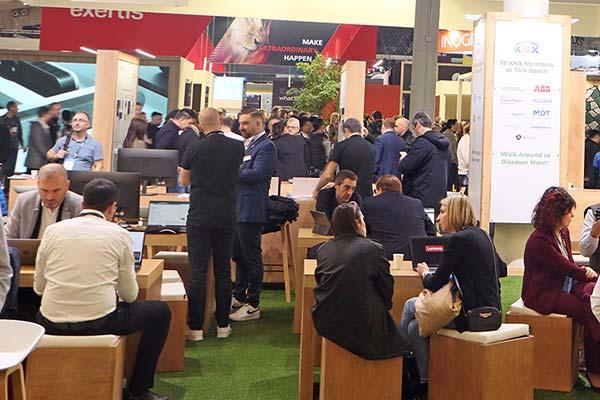
Michael Critchfield talks about demonstratingthenewETS6.3.0at ISE 2025, and shares the typical questions and topics of interest that came up at the show.
ISE Barcelona in early February was a great opportunity to showcase KNX, its members and their fantastic products, and ETS – the one commissioning tool for KNX devices. ETS Version 6.3.0 had just been released so we had the pleasure of presenting it to the many visitors at the KNX Association booth.
At every trade fair, we enjoy meeting the vast KNX community and getting their feedback, and we always look forward to greeting new faces at the booth and explaining to them the benefits of ETS, the single KNX tool for programming/commissioning KNX systems. At ISE Barcelona we were very lucky in both respects.New features
Generally, there was a lot to talk about ETS at the booth, such as the latest system extensions like the KNX Security Proxy, what it does, and how it works. System integrators are eager to learn how these new devices that support KNX Proxy are commissioned in KNX installations using ETS6.
As we brought ETS6.3.0 with us to the show, we could demonstrate it live and let people experience it for themselves. Among the questions raised by attendees, a popular topic involved the practical implications of
KNX Secure and the best practices that integrators should follow. Our advice is as follows:
• Always work with the latest version of ETS. The latest version, ETS 6.3.0 includes many enhancements and bug fixes.
• Rely on ETS6 recommendations as to which devices should be downloaded.
• Export interface information to securely link a KNX Installation to a visualisation server.
The experience at the ISE 2025 fair showed that there is an abundance of topics, features and workflows to discuss – much more than could be covered here. That is why it is recommend that you consult your local KNX Training Centre to take your expertise to the next level.
Did we identify a trend regarding ETS at ISE? Absolutely; an increased interest or concern for cyber security and data privacy. Stand visitors wanted to talk and learn about KNX Secure, passwordprotected projects, 2-factor authentication and our ETS Project Password Manager. This feature prevents the user from having to repeatedly enter a Project Password, and can restore access to Projects when you have forgotten your Password. My article covering this can be found here.
A big delight at the KNX booth at ISE 2025 was the growing interest in KNX IoT for device communication, and manufacturers, as well as systems integrators, were able to have their first experiences with this latest KNX communication medium.
Not only were we able to present KNX IoT devices in ETS6, but also on the display/demonstration panels of our member companies. This triggered conversations on the next devices that integrators are looking out for and what manufacturers are interested in bringing to the market.
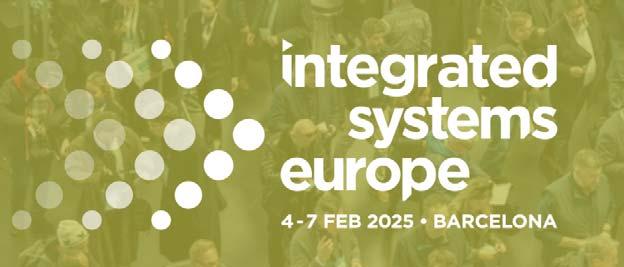

Beside fields devices, EAE Technology has full range of backend devices and sensors. Actuators, dimmers, interfaces, gateways and all system devices are available. Robustness of panel devices and variety of sensors attracts system integrators. Devices are being tested and approved by accredited laboratories for EMC, LVD, aging, lifetime tests.
Limitless combination of switch, thermostat and sockets
Compatbility with BS, EU and modular sockets
Combination of up to 5 different modules in same monoblock plate

RGB backlight
Colored LCD
Up to 6 etxra switching buttons (in addition to thermostat control buttons)
Single, double, tripple press options
Combination with switch, card holder and socket



There are more than 1 million active KNX and DALI products in different projects all around the World.
EAE Technology’s Technical Support and Training, Project Desing, After Sales and Quality departments are in service for following the projects hand to hand.
Responsible person: Ozge Goresim Deniz ozge.goresim@eaegroup.com

With endless design possibilities and uniform colour changing covering the entire colour range, Explora Halo Spectrum by Hacel delivers powerful performance. Allowing engaging and imaginative concepts to be created, the elegant LED pendant is available in Midi (1236 Ø ) and Micro (1077 Ø) sizes bringing lighting to life.
Hacels range of innovative LED luminaires can incorporate the latest Bluetooth Low Energy control platforms, offering intelligent, revolutionary wireless lighting control.

The Countdown has started: be part of Light + Building 2026
Urbanisation and the high demand for living space create challenges for cities: new buildings are expensive and many properties remain empty. Flexible utilisation concepts and sustainable renovations are in demand. Intelligent spatial planning integrates energy-efficient technologies, smart infrastructure, renewable energies and intelligent lighting concepts. Light + Building from 8 to 13 March 2026 in Frankfurt am Main will showcase these innovations. Exhibitors can register now for the world's leading trade fair for lighting and building services technology.
Light + Building gets started for 2026: Exhibitors can already register now. Companies that declare their participation by 30 April 2025 will benefit from the attractive early bird price. After that, the regular stand rental prices will apply. All information on participation at: www.lightbuilding.com/intention-exhibit
The world's leading trade fair for lighting and building services technology is the international meeting place for manufacturers from the fields of lighting, electrical
engineering, home and building automation and connected security technology. Planning for the 2026 event has already begun. Steffen Larbig provides an initial outlook: ‘My experienced team, our partners and I are working hard to continue the success story of Light + Building in 2026. There are already many exciting projects on the horizon that will characterise the industry meeting place. I can therefore already say that it will be an attractive platform for architects, interior architects, designers, planners and engineers as well as for trade, commerce and industry across all trades in a very international and attractive environment in the centre of Frankfurt and in the heart of Europe. We are looking forward to talking to all the companies that want to take part in order to create the best possible conditions for the presentation of their respective companies, personal meetings with customers and, of course, business.’
Be Electrified – Electrifying Places. Illuminating Spaces
The motto of the international innovation show in 2026 is ‘Be Electrified - Electrifying Places. Illuminating Spaces.’ This underlines what has been driving the lighting
and building services technology sectors for a long time. ‘The electrification and digitalisation of existing buildings in particular continue to be major and fundamental topics,’ explains Steffen Larbig, Brand Manager of Light + Building.
The addition of ‘Electrifying Places’ and ‘Illuminating Spaces’ places the two major core areas of lighting and building technology directly at the centre: Electrifying Places refers to the constant development and connectivity of urban spaces and the need to efficiently electrify buildings and supply them with electricity in a sustainable way. Illuminating Spaces focuses on the design aspects of lighting technology. Whether indoors or outdoors, lighting is more than just a functional light source. Design, material and styling combine harmoniously with architecture and surroundings and directly characterise the emotional experience of a space.






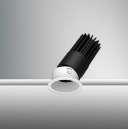
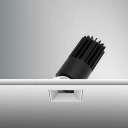

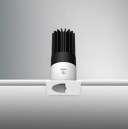

a complete range of 1.5" aperture downlights
n Very small-aperture, low-brightness downlight for general and accent illumination.
n High-lumen output and excellent color rendition for all applications.
n Multiple housing styles for mounting into all ceiling types.
n Very shallow ceiling depth required for both integral and remote drivers.
n 20º, 25º, 35º, 50º beam angles and Wallwash.
n Interchangeable optics and accessories.
n L70 (TM21 Projected 85ºC) = Static White 33K hours, Warm Dim 55K hours.
n Downlight UGR <16 meeting WELL Building criteria.
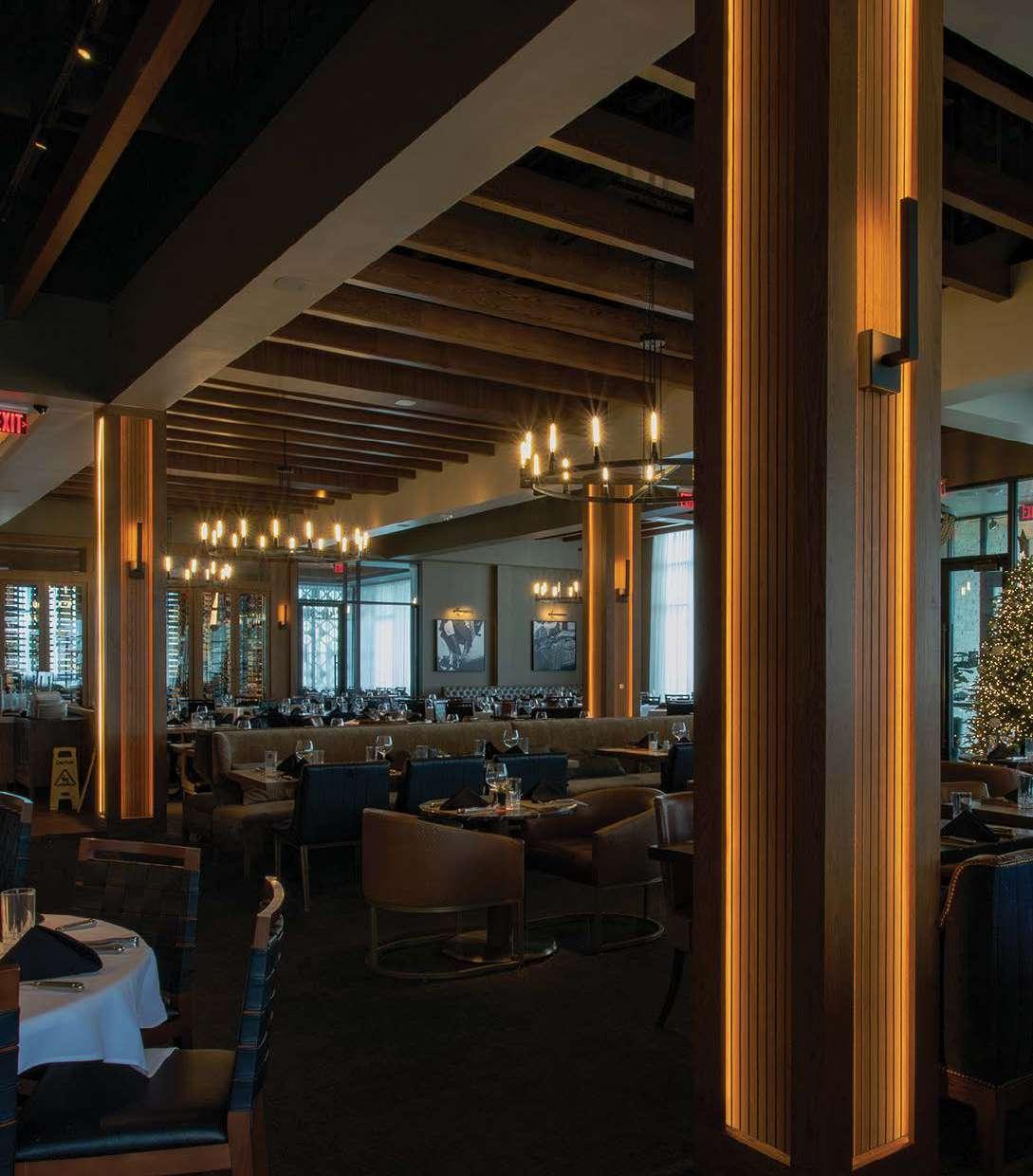
Product: TivoTape
Location: Fogo de Chão / Huntington Beach, California
Tivoli provides solutions for your projects, from customized vision to large-scope designs that produce the right amount of light where needed. Tivoli has maintained a customer-first approach, with quality products and uncompromising service year after year. Follow Us!



With endless design possibilities and uniform colour changing covering the entire colour range, Explora Halo Spectrum by Hacel delivers powerful performance. Allowing engaging and imaginative concepts to be created, the elegant LED pendant is available in Midi (1236 Ø ) and Micro (1077 Ø) sizes bringing lighting to life.
Hacels range of innovative LED luminaires can incorporate the latest Bluetooth Low Energy control platforms, offering intelligent, revolutionary wireless lighting control.
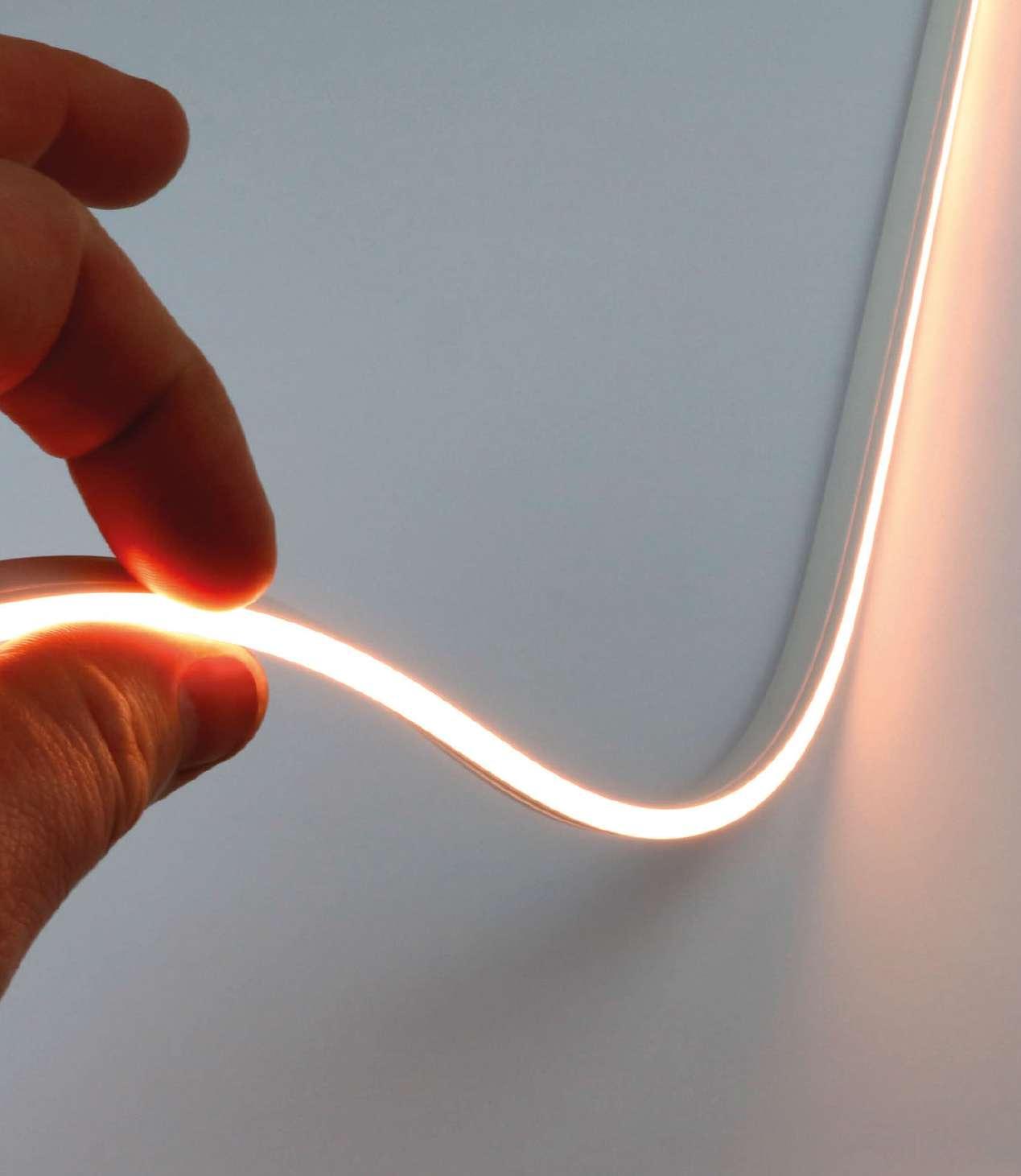
Groove FLEX
KURV-X
KURV-Y
Our flexible, fully diffused IP67 range




3 different sizes
3 powerful beam widths
Range of beautiful finishes
Easy click and fit connections
Track lighting and decorative pendants options
Call 020 7371 9000 to see it for yourself or head to our London showroom.

A challenge for Landlords and Holiday Rental services is how to get away from traditional mechanic keys and move into the digital world we live in today. Smart door locks provide a competitive
edge, enhance convenience for you and your guests, and increase your property value and service level, whatever size it is.
Go Smart Renting and forget about keys.


Download free whitepaper today:
www.assaabloy.co.uk/smartholidayrental


The Connected Room Solution Create


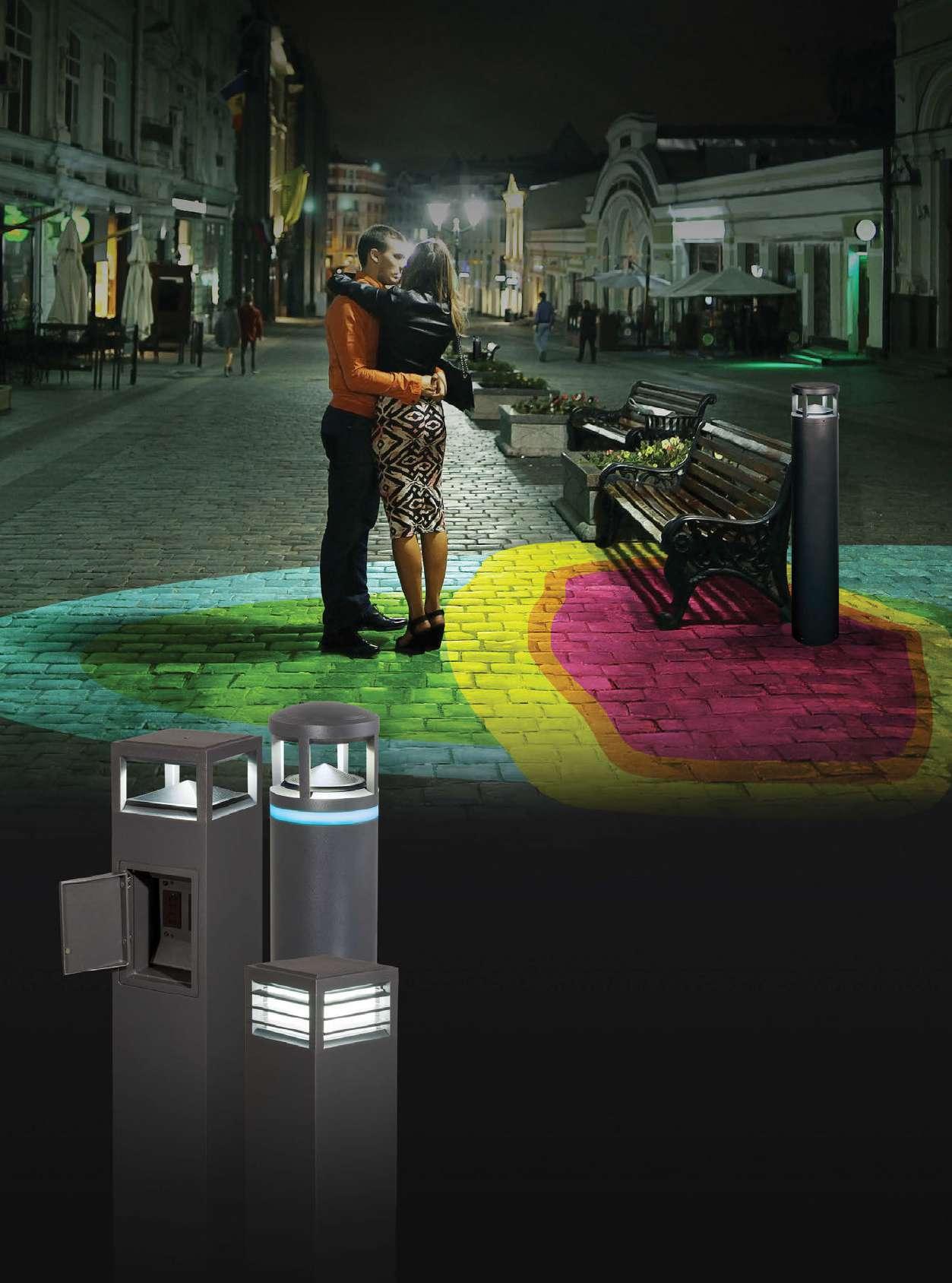
Distribution



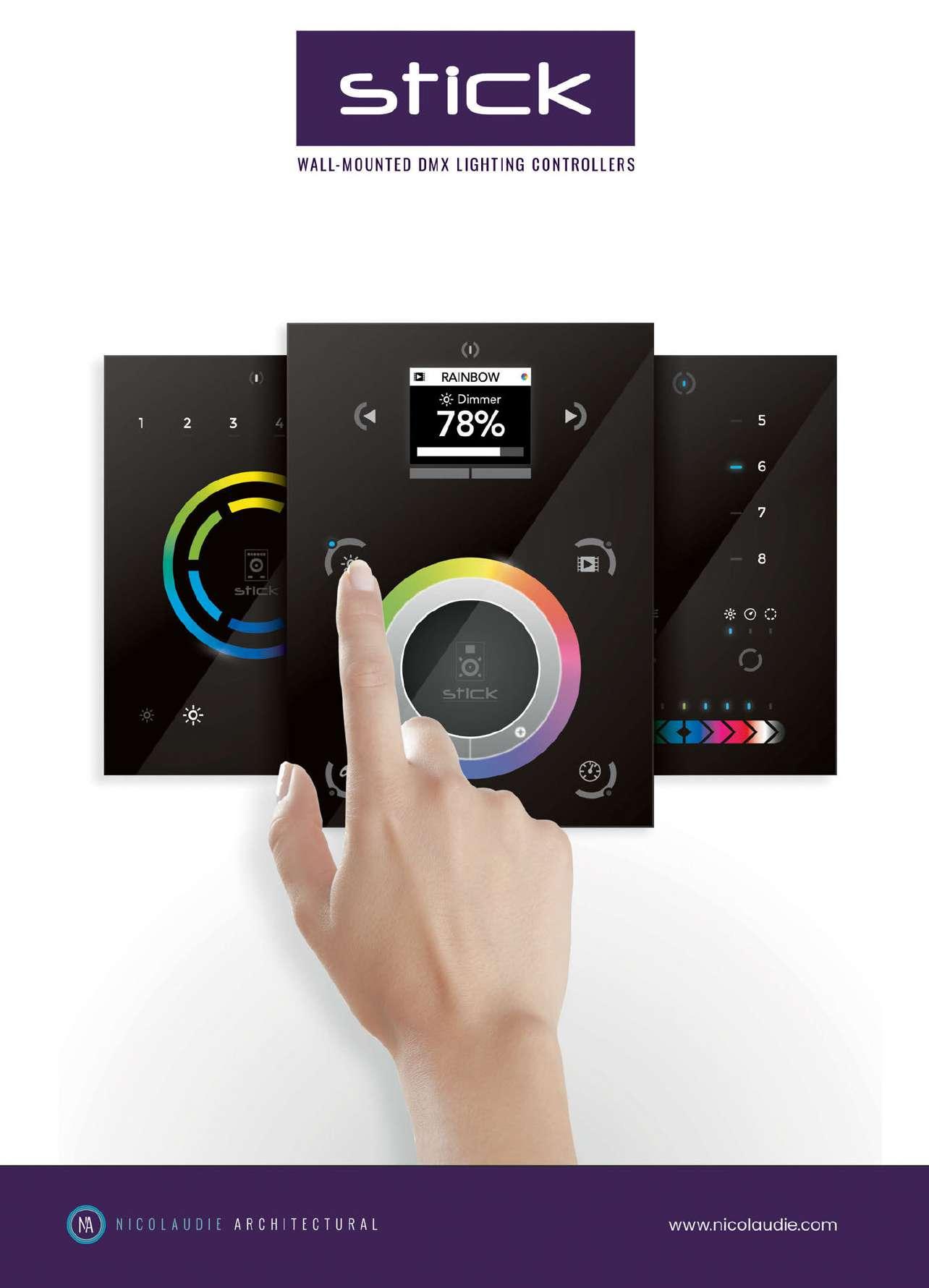

my opinion of ‘smart’

struggles to switch a light on if it has not been turned off correctly shows that the whole thing needs a rethink. I’ve found that devices such as smart plugs create ‘stupid smart solutions’ from existing technologies, in place of real intelligence and automation. They may be a good introduction, but the education must be done around true smart solutions.
Until joining Ivory Egg, my idea of a smart home was smart plugs, off-the-shelf ‘intelligent’ lightbulbs, a few clever widgets on my phone and some home assistant speakers dotted about the house.
Fast-forward a few months and KNX has unravelled this mess of isolated solutions in my mind. I now see a set of unconnected smart devices solving some issues in the home whilst causing many more. If we ignore the strain put on the home network, the fact that my partner
To that end, I’m sharing three of the reasons why I’m now an advocate of KNX. This is a fresh perspective from someone new to the industry. Take it as a reminder of points to share with your potential customers when discussing solutions. Perhaps it will remind you of why you also love working with KNX.
1. 500+ brands that would never normally work together, talk the same language
Even in the smallest of homes, the chances are that the lights, TV,
heating system and speakers are all made by different manufacturers. Each will be an expert in its particular industry but will also have its own control system.
This was unavoidable to me. Clutter was a trade-off for smarter devices. We have ‘app acne’ on our phones, ‘wall acne’ from light switches alongside thermostats, and ‘control clutter’ from a plethora of remotes. So, you can imagine my amazement when I heard that 500 manufacturers now use KNX to work seamlessly together. The scale and coverage of these manufacturers must not be underestimated. It represents an unignorable vote of confidence in KNX and its future from the tech industry as a whole. Perhaps more importantly, it means devices are talking. No more workarounds, widgets, acne or clutter. By replacing it all with a single control platform operating all devices together and in sync, the user can take charge of the building, transforming how it is
used. I find myself saying to friends, “You might not have heard of KNX, but you’ll know the brands that use it”. Namedrop a few of these and customers will soon want to know more about how it can transform their home! 2. It defines scalability
KNX is built to grow. By operating on a single standardised bus cable with a common language, it not only means different brands work together, but it also allows the system to grow easily using the existing infrastructure. That means every time a manufacturer joins the KNX contingent, you can be confident in scaling up projects and adding in new devices.
The bus cable also removes limitations associated with devices operating directly on the network. KNX gives you the option to have a dedicated line of communication for the smart home, unencumbered by other users. Updating the hardware and software of the system is a
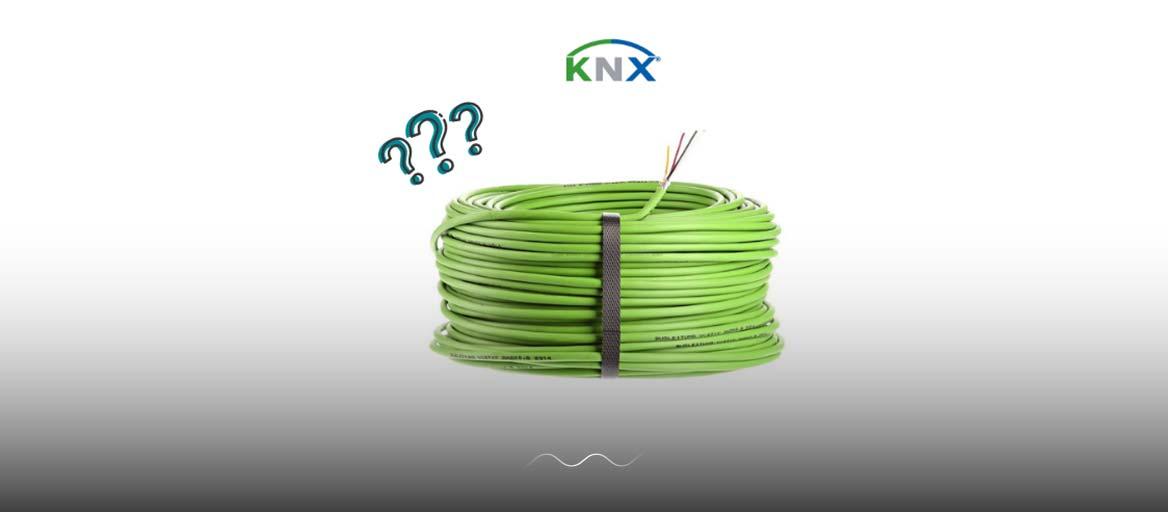
KNX uses a simple twisted-pair cable to connect all devices.
support service that you can easily sell to customers, while backwards compatibility means growing projects comes without worry. This is the backbone of a smart building.
3. It could save the planet
Many of the benefits associated with KNX are obvious. Enabling full building control, saving time and having access to more manufacturers that all speak through a single control system is great. But what about the benefit to the planet?
Lower operating costs are a major draw for many to KNX, but when you look at the bigger picture you realise something more is happening. We’re unconsciously improving our relationship with energy. The most efficient system is one that is off. Heating a room often means heating an entire home. We light a hallway all evening but only walk down it a few times. Many systems are not built to consider how we use space and thus energy. By becoming conscious of the ‘why’ and building a solution around this we can deliver efficient automation that accommodates the occupant. Furthermore, ventilation has become a safety necessity in more recent times. The ability to monitor room occupancy and use the HVAC system to keep occupants healthy takes this idea of saving the planet to a new level.
Since I joined Ivory Egg, the number of manufacturers working on KNXcompatible devices ticked past the 500 mark and innovations are being made every day to continue its development. At 30 years old, the pace of change is phenomenal and the ability for KNX to improve people’s lives is still only in its infancy.
I’ve been revisiting if dumb devices, that I previously thought were amazing, offer any of the above


benefits to my life. Are the lights coming on when the room gets dark or when the system believes it to be sunset? Is the heating coming on because it is cold and people are home or because it usually would? Is there even water in the kettle or is the smart plug just a gimmick to boil it?
In most cases, these devices now sit in a box under the bed. Consumer smart devices are more of a novelty, whereas KNX systems are changing the way people interact with their homes and energy.
So, I encourage you; next time you’re speaking to someone about a project, think about the reason you’ve bought into KNX and what it means for homeowners, the industry and the planet. Give them the introduction I’ve had – they will be sold!

Is intelligent control of all connected devices just a dream?

Joost Demarest explains how media couplers with KNX Security Proxy functionality can be used to integrate non-KNXSecure installations with KNX Secure RF products. KNX Secure covers several use cases where KNX communication is limited to a group of authenticated devices, or the system communication as a whole is protected against eavesdropping or manipulation.
In particular, it secures the following use cases:
Remote access to the installation (KNX IP Secure Tunnelling). The configuration of devices in the installation (KNX Data Security, KNX IP Secure Device Management). Run-time communication of certain applications (KNX Data Security). KNX communication in open IP networks (KNX IP Secure Routing). KNX communication in open Subnetworks (KNX Data Security).
The last use case covers the common scenario where a (possibly already-existing) wired KNX installation, i.e., a KNX TP (twisted-pair) installation, is extended with KNX RF S-Mode devices via a media coupler. Extending an existing KNX TP installation with KNX RF via a media coupler (original image source: Weinzierl Engineering). In contrast to twisted-pair cable that is hidden behind walls and ceilings, and thereby provides basic security against outside attack, the KNX RF wireless spectrum is an open medium that can be easily accessed anonymously from outside the installation.
It is therefore a legitimate requirement to secure all communication within this KNX RF subnetwork, but at the same time, allow integration of KNX RF Secure devices into applications that exist unsecured on the KNX TP segment. An example of
this would be adding a secured KNX RF pushbutton that participates in the same group as unsecured KNX TP pushbuttons and an unsecured KNX TP light switch actuator.
To achieve this, the coupler device that separates the to-be secured subnetwork from the unsecured subnetwork, must act as a middleperson when routing KNX Frames from one subnetwork to the other, and transparently add or remove the KNX Data Security to or from the KNX Frame. A coupler device with an optional security proxy functionality thus allows for a Group Address to be configured securely for one of its subnetworks, but without security (i.e., ‘plainly’) for its other subnetwork. In other words, it can transparently translate between secure and plain communication, making runtime communication between devices in different subnetworks via this Group Address
possible. Example of how a coupler device employs KNX Security Proxy functionality to allow for secure Group communication for one of its subnetworks, and plain Group communication for its other subnetwork.
Translating unicast (point-to-point) runtime communication between secure and plain is not supported by a KNX Security Proxy, neither is (system) broadcast runtime communication. However, the security proxy includes methods to temporarily enable unicast and (system) broadcast routing between specific Individual Addresses.
The security proxy is applicable only for segment couplers, line couplers and backbone couplers.
Joost Demarest is the CTO/CFO of KNX Association, the creator and owner of KNX technology – the worldwide standard for all applications in home and building control.
For 30 years, Lumascape has transformed spaces through light and color using some of the most innovative solutions.
Our innovation and technology can be seen on buildings, bridges and monuments throughout the world, creating dazzling displays of performance art.
Our specialties include:
■ Exterior-Grade Architectural Lighting
■ Intelligent Lighting Systems
■ Lighting System Design
■ Commissioning Services
■ Content / Light Show Creation
■ Remote System Monitoring
To learn more, visit lumascape.com.



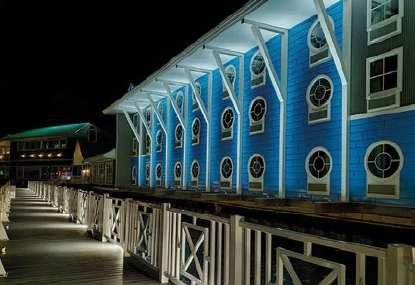


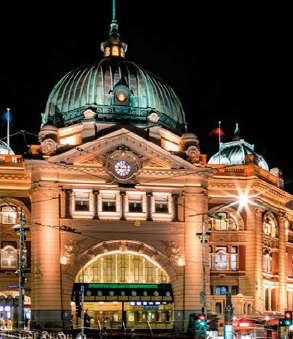



New from LightGraphix is a range of high quality miniature wall washers. The minimal design of the LD95, LD96 and LD97 allow them to blend seamlessly into most project styles, and fit into the smallest of details. A choice of beam angles and LED colours provide the designer with a number of uses, which include window reveal lighting, wall washing and path illumination. The new line up utilises the same light engine and optics as our popular LD56 uplighter, which means consistent lighting effects can be achieved across entire projects.
New from LightGraphix is a range of high quality miniature wall washers. The minimal design of the LD95, LD96 and LD97 allow them to blend seamlessly into most project styles, and fit into the smallest of details. A choice of beam angles and LED colours provide the designer with a number of uses, which include window reveal lighting, wall washing and path illumination. The new line up utilises the same light engine and optics as our popular LD56 uplighter, which means consistent lighting effects can be achieved across entire projects.
Please visit our website for more information.
Please visit our website for more information.











The ProKNX Aragon voice control system works offline to control KNX automation, and is therefore not dependent on an Internet connection (image source: ProKNX SAS).

Simon Buddle argues that whilst KNX installations are inherently robust, if we add the Internet to our control system infrastructure, we should at least mitigate against outages and access issues.
I heard on the radio last week someone describe Google as part of the infrastructure for modern day living. Indeed, the Internet is part of this infrastructure; it is the digital equivalent of roads, motorways, and international flights, allowing you to be anywhere in the world almost instantly.
It is true to say that 99% of the time we don’t know where the digital information we are seeking or currently viewing actually lives. Huge server farms exist all over the world holding vast quantities of data that is available for us to access 24/7. That is, right up to the point when we suffer an Internet outage. Whilst this is increasingly unlikely, it is not impossible. And of course there are simple solutions for backup. A ‘failover line’ backup broadband connection, either wired or over 4/ 5G, can prove effective at combatting outages. Alternatively, the Starlink low-orbit satellite-based system equally offers a workable solution.
A failover line can automatically switch to an alternative carrier should the primary Internet connection go down.
The user interface
Just as many installers believe that all
system functionalities should exist on the KNX bus, providing the customer with a robust system that relies solely on the bus cabling, actuators and keypads, so, the same logic could be applied to user interfaces or apps. Most, if not all, customers will have a user interface of some description, i.e. a device that brings together all facets of the system onto a single unified device. This device will most likely offer additional controls such as timers, scene saving options, and/or occupancy simulation.
The user interface brings together all facets of the system onto a single unified device.
Whilst we might consider the app as an integral part of a KNX system today, commonly, it requires more than the KNX bus to enable it to work. As a minimum, we’ll need a data network, often with PoE (Power over Ethernet) as the physical link layer if it is a static screen that has been installed as part of the fabric of the building.
Wall panels typically require at least a data network and a PoE connection (image source: Arqtech Automação).
Smart phones and tablets will need Wi-Fi and/or the Internet. Whilst this is an area that we consider part of the infrastructure, it is a digital domain that is largely outside of our control. The youths of today often understand their life as one of a digital existence and a real-world existence. Much has been debated
about screen time for children and the negative impact it can have –nothing to do with this article, just further proof of the dependency we have on the Internet. We have control of the Wi-Fi in the house, but not the Internet.
Should we rely on Internet access as part of a control system?
The answer clearly is ‘no’. We are controlling multiple systems through one integrated platform and whilst the Internet is ubiquitous, it should not be relied upon. And equally, most people are annoyed when it doesn’t work. Think gamers. From a system design perspective, this raises a few important questions. There’s no right or wrong here, just an appreciation of the implications and awareness on behalf of our clients.
Starting with the physical location of the app, where are the noughts and ones kept? If they live in the cloud, we’ll need the Internet up and running. That’s fine when the client moves in, but during commissioning, that might pose an issue. So perhaps it would be best to set everything up in the workshop. If the app resides on a product in the home, then we’re good to go once the data network and Wi-Fi are up and running. Typically, this will be part of our remit from an installation and commission perspective, but not always. If not, we need to allow some time to discuss and agree our

requirements with the IT/data company. It may be best to have a separate VLAN for our kit.
If the app resides inside the property, then we have to consider how the end-user connects to it from outside the home. Secure remote access is a common feature for many manufacturers now, but it still must be set up and tested. It does, clearly, require a router and Internet connection. For many clients, Apple HomeKit, Google Home or Alexa is the user interface of choice. For that you’ll need a KNX bridge such as the 1Home Bridge, the Atios KNX Bridge, or similar.
Whilst it’s easy to forget exactly where software/apps live in this day and age, it is incumbent upon us to know this clearly and to be able to relay it to our customers. There are no rights and wrongs, just nuances that may lean a client in one direction or another. Our skill is to inform, discuss and install accordingly. It is for the customer to decide which of the options is right for them. The KNX world provides so many options that we are always able to offer a solution. No other product set can achieve that.

For clients who prefer voice control, a suitable KNX bridge will be required such as the (L) 1Home Bride or the (R) Atios KNX Bridge. Conclusion



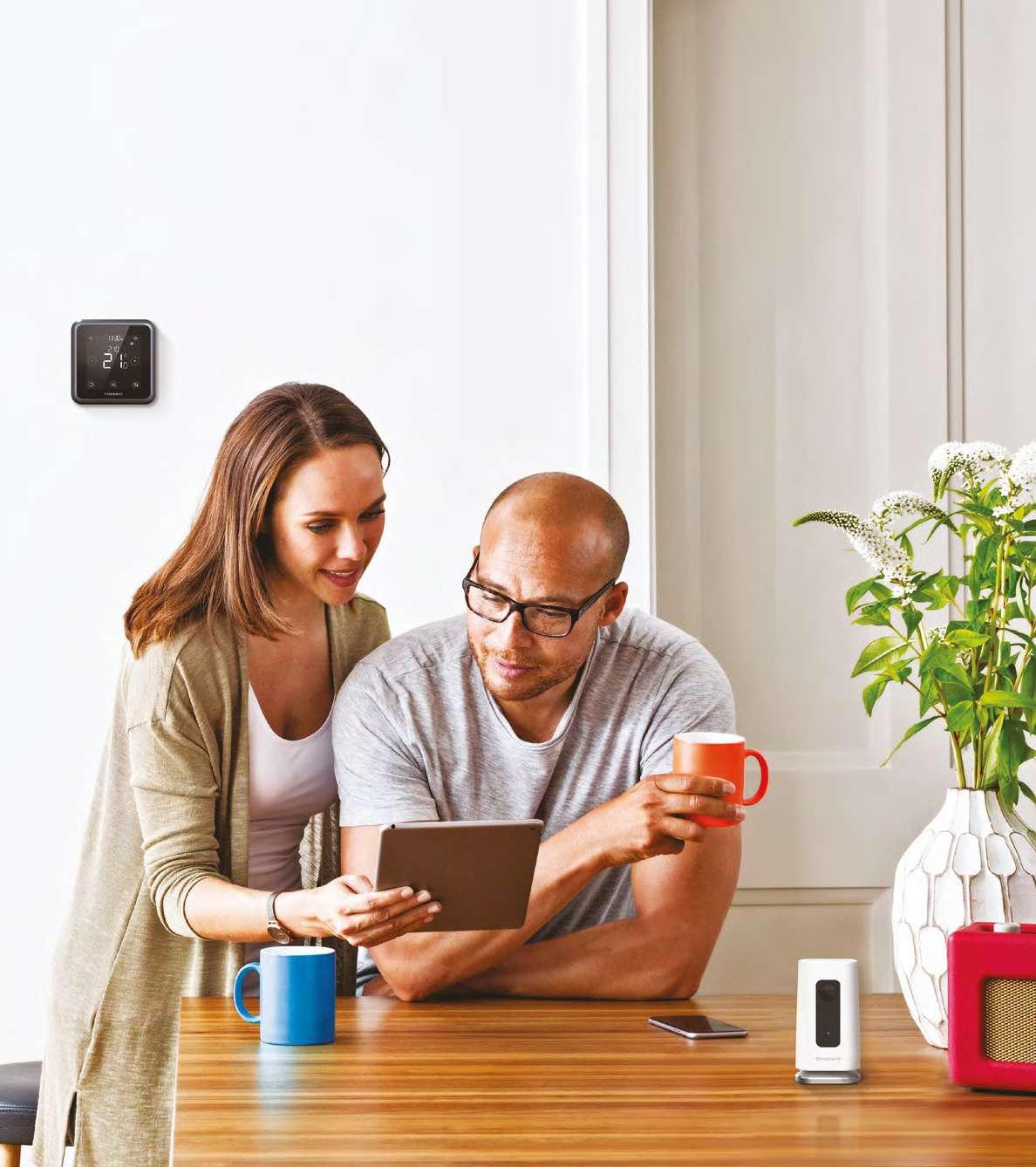

Electrical installations in both industrial and consumer buildings need to meet the new challenges of our growing power needs. To increase the energy efficiency of buildings, while at the same time integrating consumers into the load compensation, will mean that controlling the switching of electrical devices on or off according to external signals, such as time and consumption, will be vital. www.new.abb.com/smartgrids/ smart-grid-technologies/smarthome-and-intelligent-buildings
Electrical installations in both industrial and consumer buildings need to meet the new challenges of our growing power needs. To increase the energy efficiency of buildings, while at the same time integrating consumers into the load compensation, will mean that controlling the switching of electrical devices on or off according to external signals, such as time and consumption, will be vital. www.new.abb.com/smartgrids/ smart-grid-technologies/smarthome-and-intelligent-buildings
Based on the Connected Building Platform from Bosch Software Innovations
ASSA ABLoY is the global leader in door opening solutions, dedicated to satisfying end-user needs for security, safety and convenience. Since its formation in 1994, ASSA ABLoY has grown from a regional company into an international group with about 46,000 employees, operations in more than 70 countries and sales close to SEK 68 billion. The Group has a leading position in areas such as access control, identification technology, entrance automation and hotel security. www.assaabloy.co.uk/en/local/uk/ The Bosch Smart Home range includes both
Based on the Connected Building Platform from Bosch Software Innovations
Designed to be offered as a service from the ground up. Enabling our channel partners – insurers, telcos and builders - to add value to their core business creating a more intimate relationship with their consumer and B2B customers. The Cozify
Designed to be offered as a service from the ground up. Enabling our channel partners – insurers, telcos and builders - to add value to their core business creating a more intimate relationship with their consumer and B2B customers. The Cozify platform offers complete flexibility in data gathering and utilization. If so chosen, none of the data leaves the Cozify Hub. Alternatively, with consent from end users, the data can be extracted and analysed to support business decision making.
ASSA ABLoY is the global leader in door opening solutions, dedicated to satisfying end-user needs for security, safety and convenience. Since its formation in 1994, ASSA ABLoY has grown from a regional company into an international group with about 46,000 employees, operations in more than 70 countries and sales close to SEK 68 billion. The Group has a leading position in areas such as access control, identification technology, entrance automation and hotel security. www.assaabloy.co.uk/en/local/uk/ The Bosch Smart Home range includes both Single System products and System Solution products. Test the range of smart solutions to understand how these products are able to assist you in your daily lives; offering additional comfort, security for peace of mind and energy efficiency, saving you money within your home. Connectivity is more than just technology, it is now part of our every-day lives making life easier and allowing more time for the things that really matter!
www.bosch-smarthome.com
www.en.cozify.fi/pages/for-partners


https://careers.dyson.com/
Connected products is a growing area for Dyson building world-class cross functional Agile teams and adopting the latest technology and techniques delivering our ambitious vision in the connected space. In 2016 we launched our first two connected products now having a connected user base of hundreds of thousands in twenty countries. Culture of design and engineering excellence with an innovative start up mentality winning the 2016 T3 Connected product of the year. https://careers.dyson.com/




Enado has over 15 years of experience in the installation and provision of home automation systems. our multiple award winning platform allows multiple, disparate manufacturer systems and devices in the home, integrated into one solution. Industry standard offering of lighting and energy to facilitate control of multiple consumer electronics devices including satellite receivers, smart tv’s, sky and other satellite boxes. www.enado.com



Smart Door Lock Report reveals opportunities for System and Service providers and Retailers.
Energenie is part of Sandal Plc a public listed uK technology company, Sandal Plc is the brand and IP owner of the Mi|Home smart home system. The Mi|Home ecosystem can control heating, lighting and electrical appliances via both plug and play and retro fit actuators, including radiators valves, retrofit wall sockets and retro-fit light switches. The system also includes a range of sensors that are able to control the Mi|Home actuators allowing for a smarter experience. https://energenie4u.co.uk/
assaabloy.co.uk/smartreport2016
eQ-3 Group is one of the leading innovation and technology companies for home control and consumer electronics. eQ-3 provides the largest product portfolio in the industry and has placed more than 21 million wireless home control devices in almost one million households in the market. eQ-3 is the European market leader in smart home with regard to the installed base of whole home solutions and electronic radiator thermostats. www.HomeMatic.com
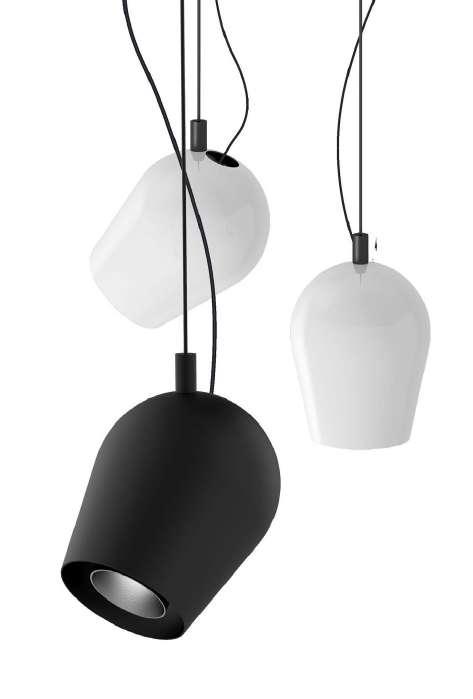

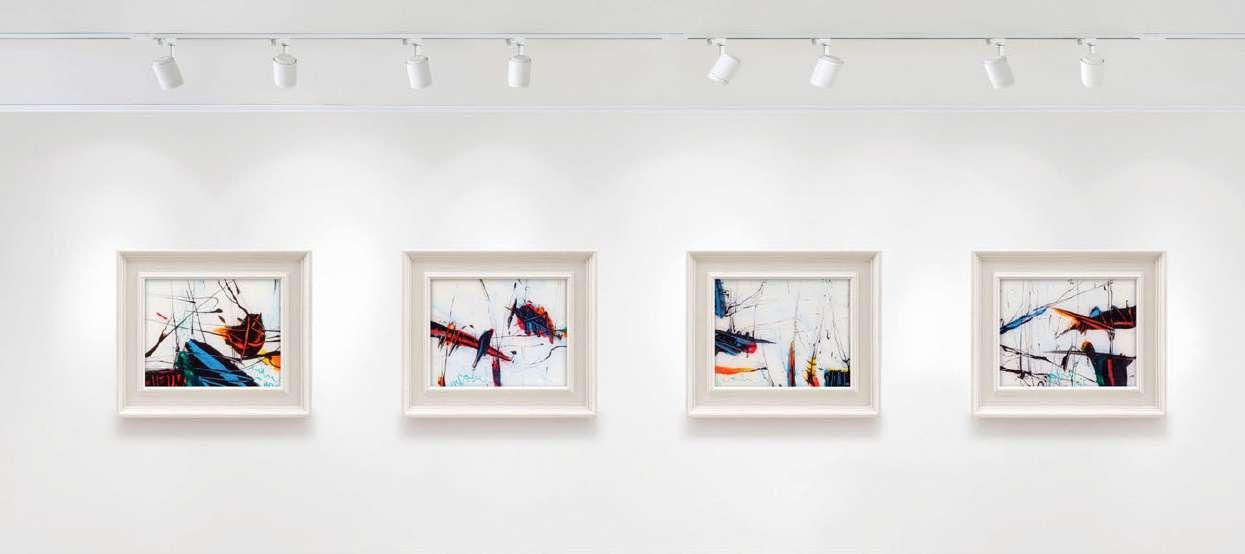


MARCO
37W 52W
High CRI up to 97 3000K 4000K 2400 to 5000 lm
Compatible with INGENIUM® ZB smart control system 12° 25° 45°


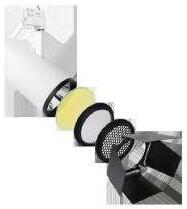
Accessories: Colour Filter (Red, Blue, Green Yellow)
Rectangular / Spread Lens Honeycomb Louvre Barn Doors
MARCO Mini 12W 13W
High CRI up to 97
2800K 4000K
720 to 1000 lm
Compatible with INGENIUM® ZB smart control system



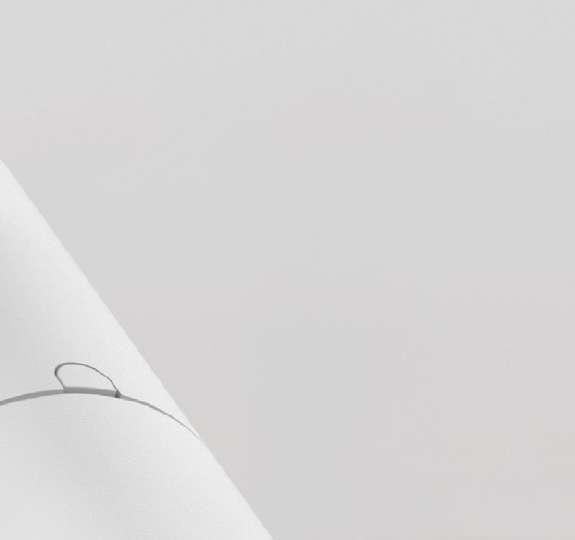





























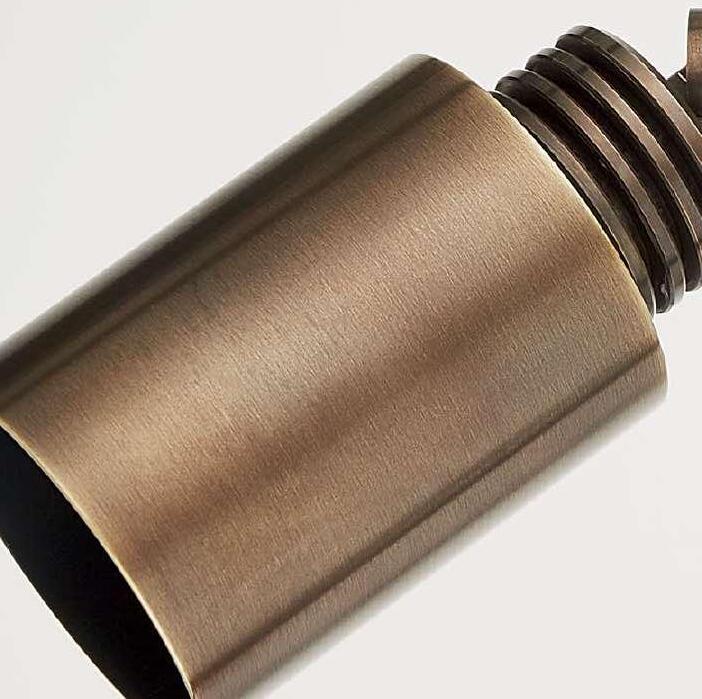


SITECO are specialists in lighting solutions for city, office, industry, sport, tunnel and retail. We are a leading supplier of professional and technical lighting solutions within indoor and outdoor applications.

siteco.com
8. – 13. 3. 2026
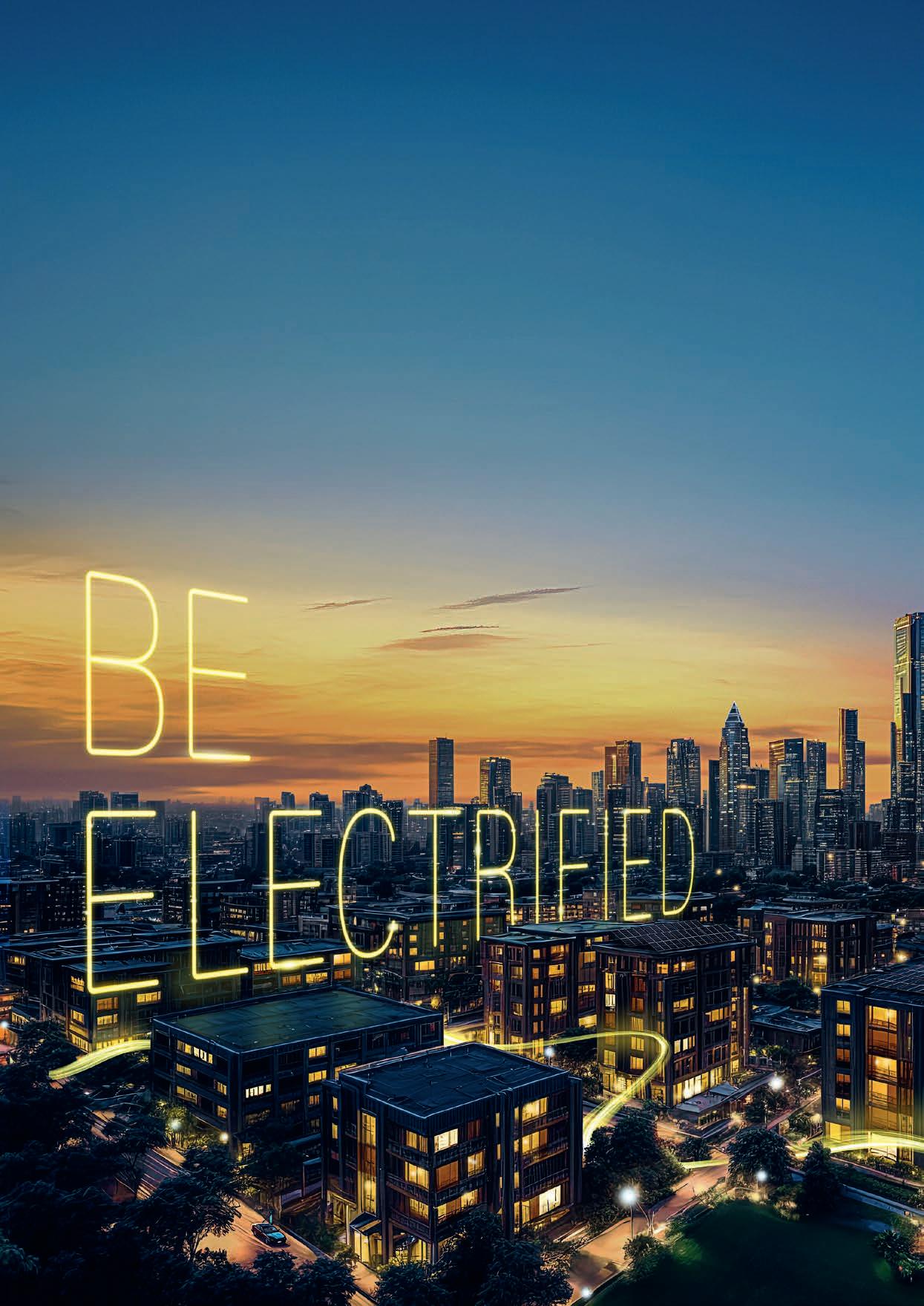
The world’s leading trade fair for lighting and building services technology